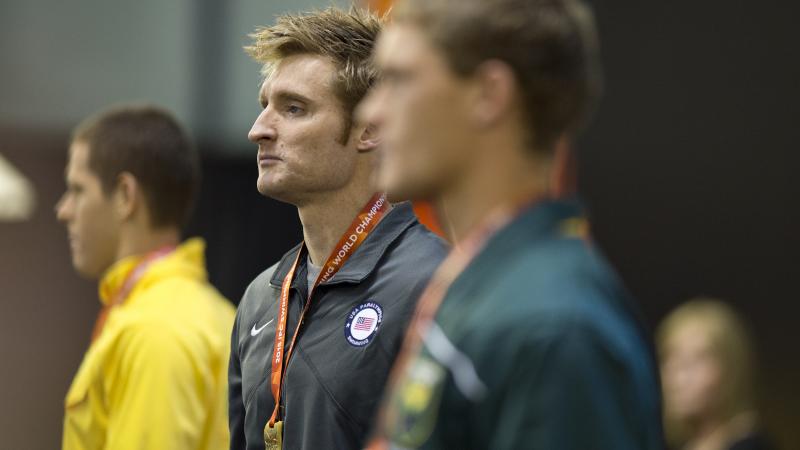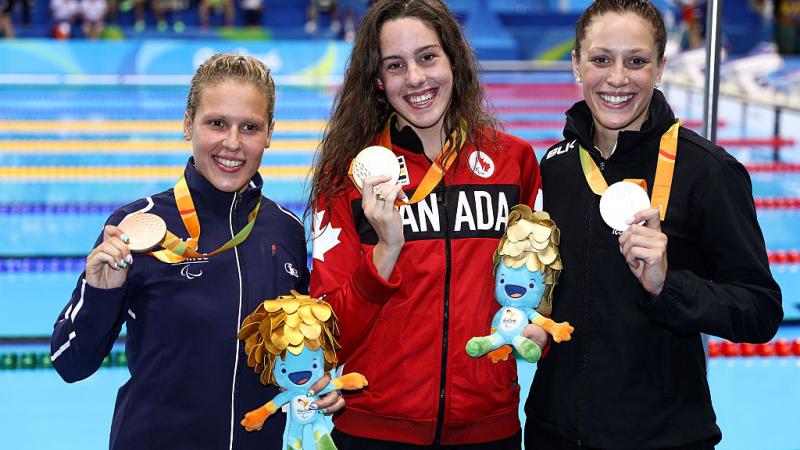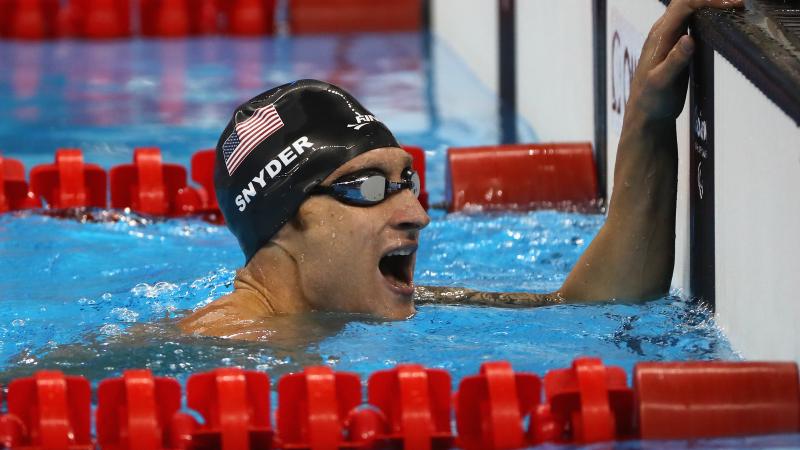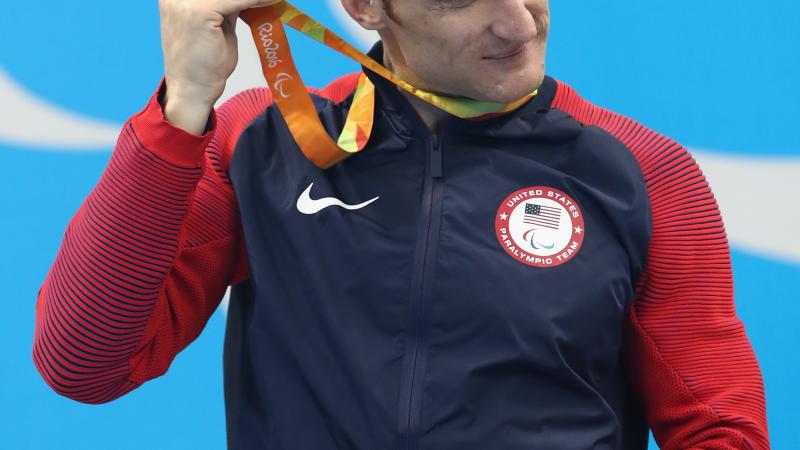How do visually impaired swimmers know where their opponents are?
Paralympic champion Brad Snyder and tapper Brian Loeffler explain their tricks in the pool. 28 Apr 2017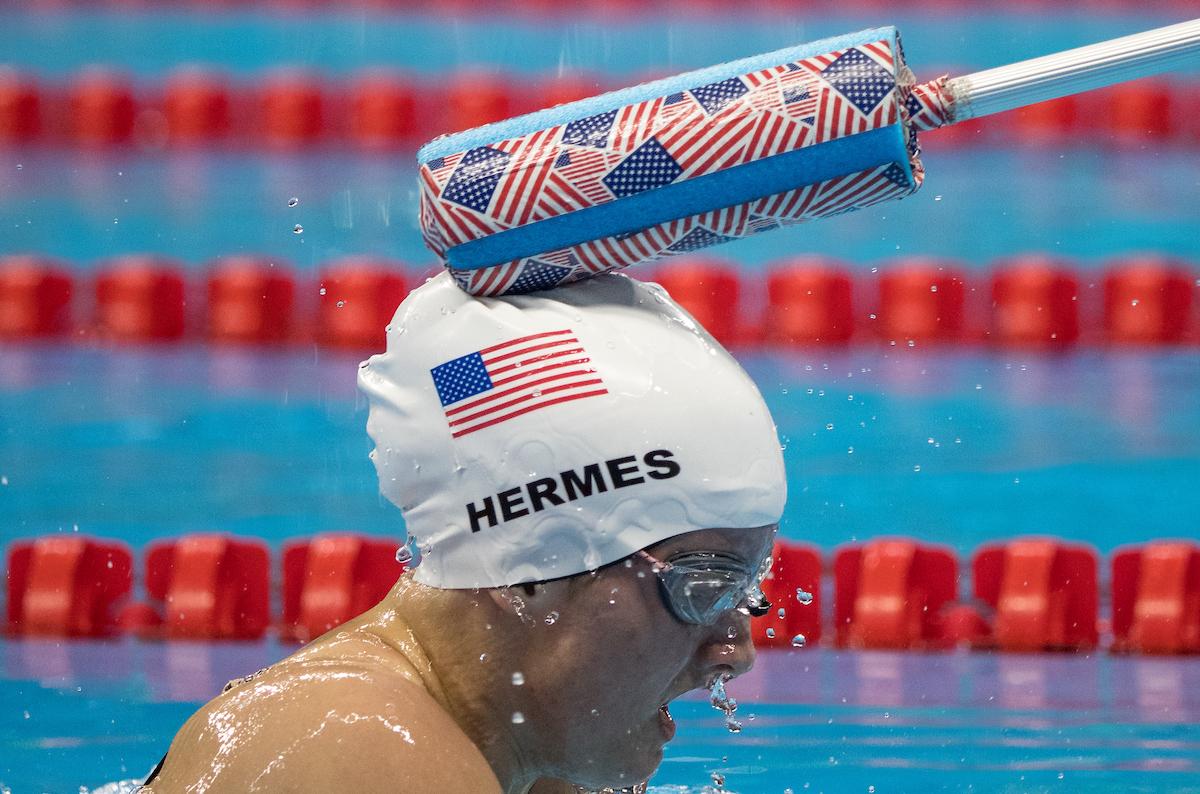
Tappers let visually impaired swimmers know when they are approaching the end of the pool. Once the swimmers recieve the tap, they know when to turn.
"The most interesting dynamic to me is that after the race, we don’t find out the outcome for quite a while because we can’t see the scoreboard"
With raging adrenaline and muscles propelling their bodies at high speeds toward a wall, visually impaired swimmers need to know – exactly – when to turn.
Otherwise, they would collide with the wall.
This is where the swimmer’s tapper comes into play.
A tapper is a person who lets the swimmer know when they are approaching the end of the pool by “tapping” them either once or twice.
Timing, the swimmer’s preference and repetition, repetition, repetition, are all important, as five-time US Paralympic champion Brad Snyder and his tapper Brian Loeffler explain the tricks and techniques to visually impaired swimming:
1. How do you manage to swim in a straight line?
Brad Snyder: Practice, practice, and more practice … and even then, I still veer off course. That being said, the ways I attempt to stay straight are by always training with symmetry in mind, both in and out of the water.
I try to train so that my body is strong on both sides, and that I am employing both sides equally. Even still, I still notice differences in strength from one side to the other. So I note these differences and compete with that awareness.
I have modified my arm recovery, dragging my fingers along the surface of the water so that if I veer off course toward the lane line, I will hopefully detect the lane line with my fingers, allowing me to correct course before I crash and lose precious time.
2. How do you know (if even) where your opponents are?
BS: I don’t! That’s the magic of blind swimming. We are not really racing each other so much as we’re racing ourselves.
3. How do you know if you are first, second, third, etc.? Or does that matter?
BS: I don’t! I often imagine that I am behind so that it’s easier to dig down deep towards the end of a race!
4. When a tapper taps your head, what does that tell you? How do you know when to turn for another lap?
BS: The tapper taps my back, not my head. When I get the tap, I immediately turn. We feel as though this eliminates any potential errors in stroke counting or whatever else. I try to simplify things as much as possible, so our strategy is ‘tap, then turn!’ Nothing else!
5. Have you been a “tapper” before you worked with Brad? What are some differences among athletes and their tapping preferences?
Brian Loeffler: Before I coached Philip Schultz who was a 2008 Paralympian. … That’s where I had my first experience and really learned how to tap.
There are other nuisances with tapping. There’s no official [tapping device].* It’s not a standard piece of equipment. It’s a really homemade device. Some people use long fishing poles. Brad would tend to use a cane that we could fold up to transport easily and it usually had a tennis ball at the end.
What also varies for each person is that some people like to be struck on the head. And some people like to be struck on the back. Brad likes the back. Philip likes the head.
6. What is key between a tapper and the swimmer?
BS: Consistency. It helps the tapper to know my race strategy and what pace I will be coming into the wall. It helps me if the tapper taps at the same point every time. When we get on the same page, the turn should look exactly like an able-bodied swimmer’s turn. You shouldn’t even be able to tell that I’m blind.
BL: I think it’s really important to have a tapper you trust because you’re swimming at a fast rate into the wall and you have to know that the tapper is going to tap you, and at a point where you’re not too far away or close to the wall.
Some other folks like a long tapping device like 14 feet long. So they get to tap further out and take a couple of strokes before they flip in. Brad’s preference is to be closer so that it’s more immediate and he knows when to flip.
7. What else is important for a tapper on the pool deck?
BL: You have to just focus on your swimmer. Don’t get distracted with what’s going on in the race, where they are in the race or where their competitors are. Don’t look at the stands. Your sole job is to focus on them and gauge their speed. It’s very much like a relay takeoff. You have to anticipate how fast they’re moving, and when the point is when they want to receive the tap.
I think some other things tappers might be afraid of when they’re starting out is being too timid. … They need to be struck fairly hard. They would rather be struck hard and feel the tap rather than question oh was that a tap? Or was that a bump on the lane line?
Tappers also can’t communicate with the swimmers. No words of encouragement or strategy.
8. What other facts should we know about how visually impaired swimmers swim?
BS: The most interesting dynamic to me is that after the race, we don’t find out the outcome for quite a while because we can’t see the scoreboard. It’s excruciating to sit in the pool, listening to everyone cheer, hoping it’s for you, but not being sure.
(*) While there are no set length regulations in the current rulebook, all tapping devices must be deemed safe by the Technical Officials at all international World Para Swimming competitions (rule 2.15.1.2).

 Facebook
Facebook
 Instagram
Instagram
 Twitter
Twitter
 Youtube
Youtube





